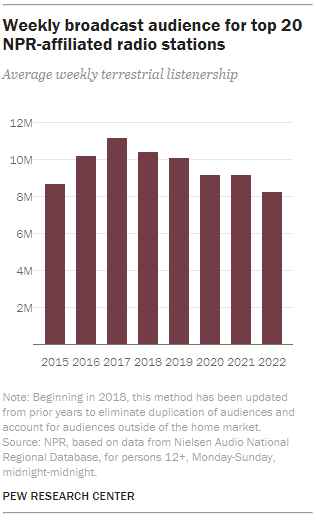☀️ Happy Thursday! The Briefing updates you on what’s happened and what’s coming in the news and information world – and what our data tells us about it. Not a subscriber yet? Sign up here!
In today’s email:
- Top story: Federal judge dismisses Trump’s defamation lawsuit against CNN
- New from Pew Research Center: A look at the state of Hispanic and Black news media. Examining the public broadcasting landscape in the U.S.
- Under the radar: The water crisis in Jackson, Mississippi, through a student journalist’s eyes
- Looking ahead: Meta is planning to create AI-powered chatbots
- Chart of the week: A look at top NPR affiliate stations’ listenership over time
🔥 Top story
A defamation lawsuit former President Trump filed against CNN was dismissed last week. The judge ruled that CNN’s statements were opinion, not false statements of fact, and thus that Trump could not sue.
In a 2018 study, Pew Research Center found that many Americans struggle to distinguish opinion statements from factual statements in the news. When shown five opinion statements and five factual statements, 26% of Americans correctly classified all factual statements as such, while 35% correctly classified all opinion statements.
🚨 New from Pew Research Center
News made by and for the two largest racial and ethnic minority groups in the United States – Black Americans and Hispanic Americans – has been a consistent part of the American media landscape. Newspapers and television aimed at each of these groups have largely seen audience declines in recent years. Our new fact sheet explores the trends in Hispanic- and Black-oriented news outlets.
Hundreds of local and regional radio and television stations make up the U.S. public media system. On the whole, the news offerings of U.S. public broadcasters have been marked by relative financial stability, with some declines in audience since 2020. Explore the patterns and trends in public broadcasting over time in our new fact sheet.
🕵️ Under the radar
- The water crisis in Jackson, Mississippi, through a student journalist’s eyes
- How the Syracuse Journalism Lab is diversifying local reporting and training young journalists
- The closing of the last remaining news outlet in a West Virginia coal county
- After winning a Pulitzer for its Brett Favre scoop, a local news site is unionizing
- Journalists at French newspaper end strike against new far-right editor
📅 Looking ahead
Meta is planning to create AI-powered chatbots to try to retain users on its platforms, such as Facebook. These chatbots are designed to have humanlike discussions with platform users. This comes after other tech companies such as Snapchat have recently launched similar AI-powered chatbots.
According to a Pew Research Center analysis of social media and news from 2022, Facebook is one of the most widely used social media sites, with seven-in-ten Americans saying they use the site. Additionally, roughly a third of U.S. adults (31%) say they regularly get news from Facebook, although this percentage has been declining in recent years.
📊 Chart of the week
The chart this week is from our newly released fact sheet on public broadcasting. This chart shows that the top 20 NPR-affiliated public radio stations (by listenership) had an average total weekly listenership of about 8 million in 2022, down 10% from 2021.

👋 That’s all for this week.
The Briefing is edited by Katerina Eva Matsa, Michael Lipka and Mark Jurkowitz, copy edited by David Kent and compiled by Pew Research Center staff, including Naomi Forman-Katz, Jacob Liedke, Sarah Naseer, Christopher St. Aubin and Emily Tomasik.
Do you like this newsletter? Email us at journalism@pewresearch.org or fill out this two-question survey to tell us what you think.